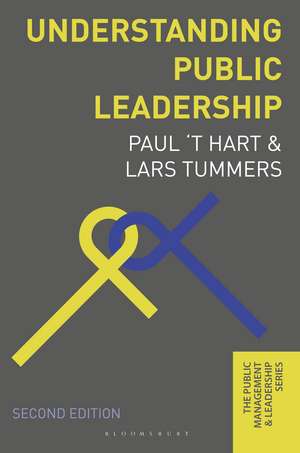Understanding Public Leadership: The Public Management and Leadership Series
Autor Paul 'T Hart, Lars Tummersen Limba Engleză Paperback – 17 sep 2019
Preț: 262.79 lei
Preț vechi: 320.63 lei
-18% Nou
Puncte Express: 394
Preț estimativ în valută:
50.29€ • 51.96$ • 41.83£
50.29€ • 51.96$ • 41.83£
Carte tipărită la comandă
Livrare economică 19 martie-02 aprilie
Preluare comenzi: 021 569.72.76
Specificații
ISBN-13: 9781352007459
ISBN-10: 1352007452
Pagini: 194
Dimensiuni: 155 x 235 x 11 mm
Greutate: 0.3 kg
Ediția:2nd ed. 2019
Editura: Bloomsbury Publishing
Colecția Bloomsbury Academic
Seria The Public Management and Leadership Series
Locul publicării:London, United Kingdom
ISBN-10: 1352007452
Pagini: 194
Dimensiuni: 155 x 235 x 11 mm
Greutate: 0.3 kg
Ediția:2nd ed. 2019
Editura: Bloomsbury Publishing
Colecția Bloomsbury Academic
Seria The Public Management and Leadership Series
Locul publicării:London, United Kingdom
Caracteristici
Comprehensive yet concisely written introduction to the various approaches to public leadership, balancing scholarly coverage with accessible discussion
Notă biografică
Paul 't Hart is Professor of Public Administration at the Utrecht University School of Governance, the Netherlands.Lars Tummers is Professor of Public Management and Behavior at Utrecht University School of Governance, the Netherlands.
Cuprins
1. Introducing Public Leadership 2. Varieties of Public Leadership 3. Leadership as Relational Work 4. Leading with Others 5. Leading in Time 6. Leading in Change 7. Leading in Crises 8. Evaluating Public Leadership.
Recenzii
't Hart and Tummers' sophisticated view of public leadership emphasizes the relevance of leaders, relationships, institutional arrangements, contexts and contingencies. Using captivating practical stories as examples, the book unravels how these factors work together to understand both what produces good leadership and what impact leadership has in public life. The authors successfully achieve their goal of conveying 'what we know of (political, administrative and civic) leadership' in the very unique and messy world of public and collective problem-solving.
This gem is essential reading for all who teach or research leadership and indeed for leaders in any field seeking an insight in their role. It is strong on dispelling popular myths, but provides very useable alternative frameworks.
Relying on scholarship from a diversity of academic disciplines, this new edition of Understanding Public Leadership provides insight into the most pressing issues in public leadership in current times. It departs from a focus on the individual leader to convincingly convey the message that public leadership should be seen as relational and collaborative. Identifying time and change as contexts and objects of public leadership, 't Hart and Tummers challenge the reader to reflect on both the state of the art of leadership research and her own leadership practice.
Paul 't Hart, now with Lars Tummers for the second edition, has pulled off another tour de force. The synthesis and exploration of public leaders and leadership from several angles is thought-provoking, insightful and engaging. This book extends, through its scholarship, the field of public leadership as a distinct field. It should be read by students, academics and practitioners alike. This area of academic work has never been more needed as the world faces a series of political, economic, social, technological and environmental challenges. Leadership responses to these challenges range from the illiberal to the democratic so this book is particularly valuable and timely.
The book contributes significantly to the literature on public leadership by discussing political, administrative and civic leadership. In contrast to the traditional focus on downward influence exerted by single individuals, the books is about leading up, down and out, and it addresses novel issues such as shared leadership. The high scientific level and very useful boxes with practical examples mean that I can unreservedly recommend it to both academics and practitioners.
The second edition of Understanding Public Leadership is a great resource, particularly for political leaders and public servants aspiring to understand the power, opportunities and vagaries of leadership. It is a wonderful teaching resource in providing a sound and highly relevant theoretical framework linked to contemporary international examples of what has both worked and failed in individual and collective leadership styles and approaches. Importantly for leaders in the public sector, it focusses at its heart on the uniqueness of public, as opposed to private, purpose and entrepreneurship. Paul 't Hart and Lars Tummers have delivered a product that will enrich debate on the centrality, rather than marginalisation, of public leadership and its contribution to public value creation.
There is a bizarre gap between the importance of public leadership in times of uncertainty and populism and its neglect in scholarly literature. Paul ´t Hart and Lars Tummers fill this gap brilliantly. Based on a sophisticated analytical scheme, they address the relevant key questions: What are the ingredients of leadership that respond to the requirements of accountability, effective problem solving and overall trustworthiness? How do leadership challenges differ in times of normalcy, accelerated change and crises? How to cope with the tension between responsiveness towards the public and defending the realm of institutional integrity? Despite its analytical depth the book is easy to read due to clarity in style and rich empirical illustrations. In its second edition, it will expand its role as a standard reference for scholars and practitioners alike.
The authors have written an excellent and concise overview of the public leadership field that is useful for both scholars and practitioners. The book is filled with valuable summaries and insights.
This gem is essential reading for all who teach or research leadership and indeed for leaders in any field seeking an insight in their role. It is strong on dispelling popular myths, but provides very useable alternative frameworks.
Relying on scholarship from a diversity of academic disciplines, this new edition of Understanding Public Leadership provides insight into the most pressing issues in public leadership in current times. It departs from a focus on the individual leader to convincingly convey the message that public leadership should be seen as relational and collaborative. Identifying time and change as contexts and objects of public leadership, 't Hart and Tummers challenge the reader to reflect on both the state of the art of leadership research and her own leadership practice.
Paul 't Hart, now with Lars Tummers for the second edition, has pulled off another tour de force. The synthesis and exploration of public leaders and leadership from several angles is thought-provoking, insightful and engaging. This book extends, through its scholarship, the field of public leadership as a distinct field. It should be read by students, academics and practitioners alike. This area of academic work has never been more needed as the world faces a series of political, economic, social, technological and environmental challenges. Leadership responses to these challenges range from the illiberal to the democratic so this book is particularly valuable and timely.
The book contributes significantly to the literature on public leadership by discussing political, administrative and civic leadership. In contrast to the traditional focus on downward influence exerted by single individuals, the books is about leading up, down and out, and it addresses novel issues such as shared leadership. The high scientific level and very useful boxes with practical examples mean that I can unreservedly recommend it to both academics and practitioners.
The second edition of Understanding Public Leadership is a great resource, particularly for political leaders and public servants aspiring to understand the power, opportunities and vagaries of leadership. It is a wonderful teaching resource in providing a sound and highly relevant theoretical framework linked to contemporary international examples of what has both worked and failed in individual and collective leadership styles and approaches. Importantly for leaders in the public sector, it focusses at its heart on the uniqueness of public, as opposed to private, purpose and entrepreneurship. Paul 't Hart and Lars Tummers have delivered a product that will enrich debate on the centrality, rather than marginalisation, of public leadership and its contribution to public value creation.
There is a bizarre gap between the importance of public leadership in times of uncertainty and populism and its neglect in scholarly literature. Paul ´t Hart and Lars Tummers fill this gap brilliantly. Based on a sophisticated analytical scheme, they address the relevant key questions: What are the ingredients of leadership that respond to the requirements of accountability, effective problem solving and overall trustworthiness? How do leadership challenges differ in times of normalcy, accelerated change and crises? How to cope with the tension between responsiveness towards the public and defending the realm of institutional integrity? Despite its analytical depth the book is easy to read due to clarity in style and rich empirical illustrations. In its second edition, it will expand its role as a standard reference for scholars and practitioners alike.
The authors have written an excellent and concise overview of the public leadership field that is useful for both scholars and practitioners. The book is filled with valuable summaries and insights.

































